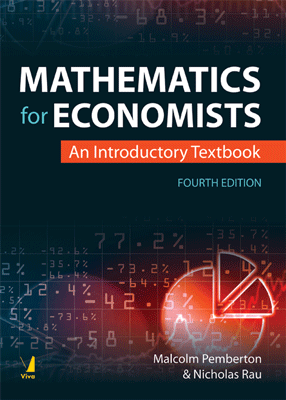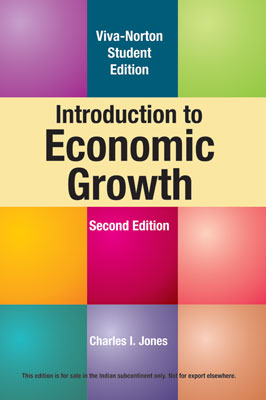Managerial Economics, 7/e
Managerial Economics, 7/e
Theory, Applications, and Cases (Viva-Norton Student Edition)
₹1,165.50 ₹1,295.00 Save: ₹129.50 (10%)
Go to cartISBN: 9788130913124
Bind: Paperback
Year: 2020
Pages: 704
Size: 7.25 x 9.5 Inch
Publisher: W. W. Norton & Company
Published in India by: Viva Books
Exclusive Distributors: Viva Books
Sales Territory: India, Nepal, Pakistan, Bangladesh, Sri Lanka
The MOST relevant content of any Managerial Economics Text. There is significant coverage of the economic crisis of 2008 and 2009. Bear Stearns, Lehman Brothers, Washington Mutual, and many other protogonists in the ongoing economic drama are discussed. And the topics of moral hazard, principal agent, adverse selection, and risk analysis — all critical for understanding the crisis — are treated at length and in depth.
The MOST experienced authors have created a text for the twenty-first century. For over ten years, Bruce Allen, Keith Weigelt, and Neil Doherty have taught the Managerial Economics course at the Wharton School of Business at the University of Pennsylvania. Managerial Economics, Seventh Edition, reflects the modern course that has evolved at Wharton. The theme of competitive strategy is maintained throughout the text; and the coverage of pricing is the most inventive available.
The MOST up-to-date case studies of any text. Managerial Economics, Seventh Edition, has nearly 100 real-world case studies, called Strategy Sessions. These sessions show students how managerial economics is practiced, using many case studies based on business news from, and events that have occurred in, 2005, 2006 ,2007 ,2008, and even 2009.
The MOST emphasis on problem solving of any Managerial Economics text. Solving problems is the best way for students to internalize the lessons of applied business economics. The many carefully solved problems ??? Problem solved boxes in the text ??? provide solutions to the types of quantitative questions that students will encounter as managers.
New to this edition: Quant Option boxes provide calculus-based explanations for advanced students. Thus, in Managerial Economics, Seventh Edition, calculus is optional, not a requirement.
Support Package for the Seventh Edition
For Students
StudySpace wwwnorton.com/studyspace
This free student website provides a rich array of multimedia resources and review materials within a proven, task-oriented study plan. Features include updated Excel worksheets with exercises, audio podcasts, review quizzes, chapter summaries, chapter outlines, and flashcards
For Instructors
Resources include image PowerPoints, lecture PowerPoints, an image gallery of art from the text, Excel exercises with answers, and an electronic test bank.
Target Audience:
Students of MBA, CA, CWA and Economics.
Contents:
Preface
Part 1: The Need for a Guide
Chapter 1: Introduction • The Theory of the Firm • What is Profit’ • Reasons for the Existence of Profit • Managerial Interests and the Principal-Agent Problem • Demand and Supply: A First Look • The Demand Side of a Market • The Supply Side of a Market • Equilibrium Price • Actual Price • What If the Demand Curve Shifts’ • What If the Supply Curve Shifts’ • Summary • Problems
Part 2: The Nature of Markets
Chapter 2: Demand Theory • The Market Demand Curve • Industry and Firm Demand Functions • The Own-Price Elasticity of Demand • Point and Arc Elasticities • Using the Demand Function to Calculate the Price Elasticity of Demand • The Effect of Price Elasticity on the Firm's Revenue • Funding Public Transit • Determinants of the Own-Price Elasticity of Demand • The Strategic Use of the Price Elasticity of Demand • Total Revenue, Marginal Revenue, and Price Elasticity • The Income Elasticity of Demand • Cross-Price Elasticities of Demand • The Advertising Elasticity of Demand • The Constant-Elasticity and Unitary Demand Function • Summary • Problems
Chapter 3: Consumer Behavior and Rational Choice • Indifference Curves • The Marginal Rate of Substitution • The Concept of Utility • The Budget Line • The Equilibrium Market Bundle • Maximizing Utility: A Closer Look • Corner Solutions • How Managers Can Strategically Influence Consumer Choices • Deriving the Individual Demand Curve • Deriving the Market Demand Curve • Consumer Surplus • Summary • Problems
Part 3: Production and Cost
Chapter 4: Production Theory • The Production Function with One Variable Input • The Law of Diminishing Marginal Returns • The Production Function with Two Variable Inputs • Isoquants • The Marginal Rate of Technical Substitution • The Optimal Combination of Inputs • Corner Solutions • Returns to Scale • The Output Elasticity • Estimations of Production Functions • Summary • Problems • Appendix: Lagrangian Multipliers and Optimal Input Combinations
Chapter 5: The Analysis of Costs • Opportunity Costs • Short-Run Cost Functions • Average and Marginal Costs • Long-Run Cost Functions • Managerial Use of Scale of Economics • Managerial Use of Scope Economics • Managerial Use of Break-Even Analysis • Profit Contribution Analysis • Summary • Problems • Appendix A: Break-Even Analysis and Operating Leverage • Appendix B: Measurement of Short-Run Cost Functions: The Choice of a Mathematical Form ‘
Part 4: Market Structure and simple pricing strategies
Chapter 6: Perfect Competition • Market Structure • Market Price in Perfect Competition • Shifts in Supply and Demand Curves • The Output Decision of Perfectly Competitive Firm • Setting the Marginal Cost Equal to the Price • Another Way of Viewing the Price Equals Marginal Cost • Profit-Maximizing Rule • Producer Surplus in the Short Run • Long-Run Equilibrium of the Firm • The Long-Run Adjustment Process: A Constant-Cost Industry • The Long-Run Adjustment Process: An Increasing-Cost Industry • How a Perfectly Competitive Economy Allocates Resources • Summary • Problems
Chapter 7: Monopoly and Monopolistic competition • Pricing and Output Decisions in Monopoly • Cost-Plus Pricing • Cost-Plus Pricing at Therma-Stent • Cost-Plus Pricing at Internet Companies and Government-Regulated Industries • Can Cost-Plus Pricing Maximize Profit’ • The Multiple-Product Firm: Demand Interrelationships • Pricing of Joint Products: Fixed Proportions • Output of Joint Products: Variable Proportions • Monopsony • Monopolistic Competition • Advertising Expenditures: A Simple Rule • Using Graphs to Help Determine Advertising Expenditure • Advertising, Price Elasticity, and Brand Equity: Evidence on Managerial Behavior • Summary • Problems • Appendix: Allocation of Output among Plants
Part 5: Sophisticated Market Pricing
Chapter 8: The Managerial Use of Price Discrimination • Motivation for Price Discrimination • Price Discrimination • Using Coupons and Rebates for Price Discrimination • Peak Load Pricing • Two-Part Tariffs • Summary • Problems • Appendix: Two-Part Tariff with Intersecting Demands
Chapter 9: Bundling and Intrafirm Pricing • The Mechanics of Bundling • When to Unbundle • Bundling as a Preemptive Entry Strategy • Tying at IBM, Xerox, and Microsoft • Transfer Pricing • Transfer Pricing: A Perfectly Competitive Market for the Upstream Product • The Global Use of Transfer Pricing • Summary • Problems
Part 6: the strategic world of managers
Chapter 10: Oligopoly • Cooperative Behavior • The Breakdown of Collusive Agreements • Price Leadership • Possible Behavior in Markets with Few Rivals • Duopolists and Price Competition with Differentiated Products • The Sticky Pricing of Managers • Summary • Problems
Chapter 11: Game Theory • Making Strategy and Game Theory • Strategy Basics • Visual Representation • Solution Concepts • Equilibria • Dominant Strategies • The Nash Equilibrium • Strategic Foresight: The Use of Backward Induction • Repeated Games • Incomplete Information Games • Reputation Building • Coordination Games • Strictly Competitive Games • Summary • Problems
Chapter 12: Auctions • A Short History of Auctions • Types of Auction Mechanisms • Auction Mechanism and Revenue Generation • Bidding Strategies • Strategies for Sellers • Value of Information • Risk Aversion • Number of Bidders • Winner's Curse • Concerns in Auction Design • Summary • Problems
Part 7: risk, uncertainty, and incentives
Chapter 13: Risk Analysis • Risk and Probability • Probability Distributions and Expected Values • Comparisons of Expected Profit • Road Map to Decision • The Expected Value of Perfect Information • Measuring Attitudes toward Risk: The Utility Approach • Attitudes towards Risk: Three Types • The Standard Deviation and Coefficient of Variation: Measures of Risk • Adjusting the Valuation Model for Risk • Certainty Equivalence and the Market for Insurance • Summary • Problems
Chapter 14: Principal-Agent Issues and Managerial Compensation • Principal-Agent Issues • The Diverging Paths of Owners and Managers • The Principal-Agent Situation • The Effect of Risk, Information, and Compensation on Principal-Agent Issues • Resolving the Incentive Conflict When Output Is Risky and Effort Is Not Observable • Some Refinements to Managerial Compensation • Principal-Agent Issues in Other Contexts • Product Liability and the Safety of Consumer Goods • Summary • Problems
Chapter 15: Adverse Selection • The Market for ‘Lemons’ • Adverse Selection in Automobile Insurance • The Market for Annuities • Resolving Adverse Selection through Self-Selection • Using Education as a Signal: Adverse Selection in the Job Market • Using Warranties as Signals: Adverse Selection in the Product Market • Summary • Problems
Part 8: Government actions and managerial behavior
Chapter 16: Government and Business • Competition versus Monopoly • Regulation of Monopoly • The Lone Star Gas Company: A Case Study • Effects of Regulation and Efficiency • The Concentration of Economic Power • The Sherman Act • The Clayton Act, the Robinson’Patman Act, and the Federal Trade Commission Act • Interpretation of the Antitrust Laws • The Patent System • Trade and Trade Policy • Government Price Ceilings and Price Floors • The Welfare Impacts of Taxes • Regulation of Environmental Pollution • Public Goods • Summary • Problems
Appendix A: Optimization Techniques • Functional Relationships • Marginal Analysis • Relationships among Total, Marginal, and Average Values • The Concept of a Derivative • How to Find a Derivative • Using Derivatives to Solve Maximization and Minimization Problems • Marginal Cost Equals Marginal Revenue and the Calculus of Optimization • Partial Differentiation and the Maximizations of Multivariable Functions • Constrained Optimization • Lagrangian Multipliers • Comparing Incremental Costs with Incremental Revenues
Appendix B: Discounting and Present Values • Present Value of a Series of Payments • The Use of Periods Other Than a Year • Determining the Internal Rate of Return
Appendix C: Answers to select end-of-chapter problems
Appendix D: tables
Index
W. Bruce Allen is professor of business and public policy, regional science, and transportation at the Wharton School of the University of Pennsylvania. Professor Allen won the Anvil Award for Teaching Excellence in 1991, and the Miller-Sherred MBA Core Curriculum Teaching Award in 1994 and 1997. He has consulted with a variety of firms and government agencies in the area of transportation and energy economies.
Neil Doherty is Ronald A. Rosenfeld Professor and professor of insurance and risk management at the Wharton School of the University of Pennsylvania. He won the Undergraduate Excellence in Teaching Award in 1997 and the Miller-Sherred MBA Core Curriculum Teaching Award in 1998. Professor Doherty has consulted with numerous major firms including Amerco, Dow Chemical, Sears Roebuck, British Petroleum, Merck, GTE, CIGNA, and UPS.
The late Edwin Mansfield was for many years a distinguished professor of economics at the University of Pennsylvania. He was an internationally recognized expert in the economics of technology and industrial organization. His numerous texts, all published by WW. Norton, have sold millions of copies around the world. In 1979, when Sino American scientific agreements were finally reached, Mansfield was the first American economist to lecture in the People's Republic of China.
Keith Weigelt is professor of strategy at the Wharton School of the University of Pennsylvania. His research interests lie in game theory, compensation, experimental economics, and the economics of sports. In addition to teaching managerial economics in the Wharton MBA program, Professor Weigelt runs the Field Application Program required at Wharton of all first year MBA students. Through this program, students work on consulting projects with a wide range of firms.







